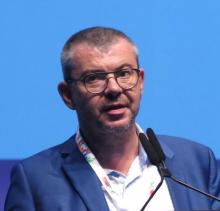User login
BARCELONA – , results of a large randomized trial and separate meta-analysis indicate.
Among nearly 1,400 men with postoperative prostate-specific antigen (PSA) levels below 0.2 ng/mL and one or more risk factors, followed for a median of 5 years, there were no significant differences in any of the secondary outcomes between men randomized to radiotherapy and observation alone, reported Chris Parker, MD, from the Royal Marsden Hospital in London.
“In comparison with a policy of early salvage radiotherapy, adjuvant radiotherapy did not improve biochemical progression-free survival and did not delay the further use of hormone therapy,” he said at the European Society for Medical Oncology Congress, on behalf of colleagues in the RADICALS-RT trial.
Results of the RADICAL-RT trial were also pooled with results from two other large trials in a collaborative series of meta-analyses of long-term prostate cancer outcomes – dubbed ARTISTIC – which found no significant differences in event-free survival (EFS) for men randomized to either adjuvant or salvage radiotherapy.
“We don’t see any evidence from the ARTISTIC results that adjuvant radiotherapy improves event-free survival, compared to early salvage radiotherapy, and our best estimate is of a small, 1% difference in event-free survival at 5 years,” said Claire Vale, PhD, a research fellow at University College, London.
RADICALS RT details
Dr. Parker presented results from an early analysis of the secondary endpoint of biochemical progression-free survival (PFS), conducted in cooperation with the ARTISTIC investigators.
In RADICALS RT, investigators in the United Kingdom, Denmark, Canada, and Ireland enrolled 1,369 men following radical prostatectomy and after stratification by Gleason score, margin status, treatment center, and radiotherapy schedule (52.5 Gy delivered in 20 fractions, or 66 Gy delivered), randomly assigned them to either postoperative radiotherapy or observation with radiotherapy.
The patients enrolled had postoperative PSAs less than 2 ng/mL and one or more risk factors, either pathologic stage 3/4, Gleason score 7-10, positive surgical margins, or preoperative PSA of 10 ng/mL or greater.
The trigger for radiotherapy in men assigned to observation was PSA failure, defined as a PSA level of at least 0.1 ng/mL or 3 consecutive PSA rises.
At the median 5-year follow-up, PFS rates were 85% for patients assigned to adjuvant radiotherapy, and 88% for those assigned to observation, translating to a hazard ratio of 1.10, which was not statistically significant.
However, there were significant differences between the groups in both self-reported urinary incontinence (5.3% of patients in the radiotherapy group vs. 2.7% in the observation group, P = .008) and grade 3 or 4 urethral stricture at any time (8% vs. 5%, respectively, P = .03).
Results of the primary outcome, freedom from distant metastases will require longer follow-up, Dr. Parker said.
ARTISTIC meta-analysis
Dr. Vale presented results of the ARTISTIC collaborative meta-analysis, which included data from three randomized trials, including RADICALS, GETUG-AFU 17, and RAVES.
The meta-analysis was designed to include a consistent definition of PSA-driven EFS, prior to the unblinding of trial results.
The definition of EFS used in the trial was time from randomization until the first evidence of either PSA of 0.4 ng/mL or greater and rising after completion of radiotherapy, clinical/radiological progression, initiation on nontrial treatment, death from prostate cancer following completion of radiotherapy, or PSA level of 2.0 ng/mL or greater any time after randomization.
They analyzed data on a total of 1,074 men assigned to adjuvant radiotherapy and 1,077 assigned to salvage radiotherapy.
In each of the three trials included in the meta-analysis, there was a nonsignificant trend toward better PSA-driven EFS with salvage radiotherapy vs. adjuvant radiotherapy. The overall hazard ratio was 1.12, with the 95% confidence interval crossing 1, indicating a nonsignificant result.
Dr. Vale noted that early salvage radiotherapy spares many men from potentially unnecessary radiation and its negative consequences. Of the men included in the trials, more than 60% of those randomized to observation with salvage radiotherapy have yet to start radiotherapy.
She noted that investigators still need to assess long-term definitive outcomes such as metastases and survival, and whether some patients may derive benefit from adjuvant radiotherapy.
Invited discussant Gert De Meerleer, MD, PhD, a radiation oncologist at University Hospitals Leuven in Belgium, acknowledged that he agreed with most of the findings of the RADICALS-RT and ARTISTIC investigators.
An important take-home message, he said, is that “cure is the aim, and radiotherapy the keystone. If you have PSA relapse after prostatectomy, you can say, ‘I don’t treat the patient’ – fair enough. But if you treat the patient, only giving systemic therapy is the wrong way to go, you have to add radiotherapy,” he said.
He also agreed that “salvage is probably the modality of choice, and it is also in a lot of European countries, provided it is early.”
The RADICALS-RT trial is supported by Cancer Research UK and the Medical Research Council UK. Dr. Parker said he had no disclosures relevant to the trial. ARTISTIC is funded by the Medical Research Council. Dr. Vale reported having no disclosures. Dr. De Meerleer reported speaker fees, advisory board activities, and scientific grants not related to the studies.
SOURCE: Parker C et al. and Vale C et al. ESMO 2019. Abstracts LBA49_PR and LBA48_PR.
BARCELONA – , results of a large randomized trial and separate meta-analysis indicate.
Among nearly 1,400 men with postoperative prostate-specific antigen (PSA) levels below 0.2 ng/mL and one or more risk factors, followed for a median of 5 years, there were no significant differences in any of the secondary outcomes between men randomized to radiotherapy and observation alone, reported Chris Parker, MD, from the Royal Marsden Hospital in London.
“In comparison with a policy of early salvage radiotherapy, adjuvant radiotherapy did not improve biochemical progression-free survival and did not delay the further use of hormone therapy,” he said at the European Society for Medical Oncology Congress, on behalf of colleagues in the RADICALS-RT trial.
Results of the RADICAL-RT trial were also pooled with results from two other large trials in a collaborative series of meta-analyses of long-term prostate cancer outcomes – dubbed ARTISTIC – which found no significant differences in event-free survival (EFS) for men randomized to either adjuvant or salvage radiotherapy.
“We don’t see any evidence from the ARTISTIC results that adjuvant radiotherapy improves event-free survival, compared to early salvage radiotherapy, and our best estimate is of a small, 1% difference in event-free survival at 5 years,” said Claire Vale, PhD, a research fellow at University College, London.
RADICALS RT details
Dr. Parker presented results from an early analysis of the secondary endpoint of biochemical progression-free survival (PFS), conducted in cooperation with the ARTISTIC investigators.
In RADICALS RT, investigators in the United Kingdom, Denmark, Canada, and Ireland enrolled 1,369 men following radical prostatectomy and after stratification by Gleason score, margin status, treatment center, and radiotherapy schedule (52.5 Gy delivered in 20 fractions, or 66 Gy delivered), randomly assigned them to either postoperative radiotherapy or observation with radiotherapy.
The patients enrolled had postoperative PSAs less than 2 ng/mL and one or more risk factors, either pathologic stage 3/4, Gleason score 7-10, positive surgical margins, or preoperative PSA of 10 ng/mL or greater.
The trigger for radiotherapy in men assigned to observation was PSA failure, defined as a PSA level of at least 0.1 ng/mL or 3 consecutive PSA rises.
At the median 5-year follow-up, PFS rates were 85% for patients assigned to adjuvant radiotherapy, and 88% for those assigned to observation, translating to a hazard ratio of 1.10, which was not statistically significant.
However, there were significant differences between the groups in both self-reported urinary incontinence (5.3% of patients in the radiotherapy group vs. 2.7% in the observation group, P = .008) and grade 3 or 4 urethral stricture at any time (8% vs. 5%, respectively, P = .03).
Results of the primary outcome, freedom from distant metastases will require longer follow-up, Dr. Parker said.
ARTISTIC meta-analysis
Dr. Vale presented results of the ARTISTIC collaborative meta-analysis, which included data from three randomized trials, including RADICALS, GETUG-AFU 17, and RAVES.
The meta-analysis was designed to include a consistent definition of PSA-driven EFS, prior to the unblinding of trial results.
The definition of EFS used in the trial was time from randomization until the first evidence of either PSA of 0.4 ng/mL or greater and rising after completion of radiotherapy, clinical/radiological progression, initiation on nontrial treatment, death from prostate cancer following completion of radiotherapy, or PSA level of 2.0 ng/mL or greater any time after randomization.
They analyzed data on a total of 1,074 men assigned to adjuvant radiotherapy and 1,077 assigned to salvage radiotherapy.
In each of the three trials included in the meta-analysis, there was a nonsignificant trend toward better PSA-driven EFS with salvage radiotherapy vs. adjuvant radiotherapy. The overall hazard ratio was 1.12, with the 95% confidence interval crossing 1, indicating a nonsignificant result.
Dr. Vale noted that early salvage radiotherapy spares many men from potentially unnecessary radiation and its negative consequences. Of the men included in the trials, more than 60% of those randomized to observation with salvage radiotherapy have yet to start radiotherapy.
She noted that investigators still need to assess long-term definitive outcomes such as metastases and survival, and whether some patients may derive benefit from adjuvant radiotherapy.
Invited discussant Gert De Meerleer, MD, PhD, a radiation oncologist at University Hospitals Leuven in Belgium, acknowledged that he agreed with most of the findings of the RADICALS-RT and ARTISTIC investigators.
An important take-home message, he said, is that “cure is the aim, and radiotherapy the keystone. If you have PSA relapse after prostatectomy, you can say, ‘I don’t treat the patient’ – fair enough. But if you treat the patient, only giving systemic therapy is the wrong way to go, you have to add radiotherapy,” he said.
He also agreed that “salvage is probably the modality of choice, and it is also in a lot of European countries, provided it is early.”
The RADICALS-RT trial is supported by Cancer Research UK and the Medical Research Council UK. Dr. Parker said he had no disclosures relevant to the trial. ARTISTIC is funded by the Medical Research Council. Dr. Vale reported having no disclosures. Dr. De Meerleer reported speaker fees, advisory board activities, and scientific grants not related to the studies.
SOURCE: Parker C et al. and Vale C et al. ESMO 2019. Abstracts LBA49_PR and LBA48_PR.
BARCELONA – , results of a large randomized trial and separate meta-analysis indicate.
Among nearly 1,400 men with postoperative prostate-specific antigen (PSA) levels below 0.2 ng/mL and one or more risk factors, followed for a median of 5 years, there were no significant differences in any of the secondary outcomes between men randomized to radiotherapy and observation alone, reported Chris Parker, MD, from the Royal Marsden Hospital in London.
“In comparison with a policy of early salvage radiotherapy, adjuvant radiotherapy did not improve biochemical progression-free survival and did not delay the further use of hormone therapy,” he said at the European Society for Medical Oncology Congress, on behalf of colleagues in the RADICALS-RT trial.
Results of the RADICAL-RT trial were also pooled with results from two other large trials in a collaborative series of meta-analyses of long-term prostate cancer outcomes – dubbed ARTISTIC – which found no significant differences in event-free survival (EFS) for men randomized to either adjuvant or salvage radiotherapy.
“We don’t see any evidence from the ARTISTIC results that adjuvant radiotherapy improves event-free survival, compared to early salvage radiotherapy, and our best estimate is of a small, 1% difference in event-free survival at 5 years,” said Claire Vale, PhD, a research fellow at University College, London.
RADICALS RT details
Dr. Parker presented results from an early analysis of the secondary endpoint of biochemical progression-free survival (PFS), conducted in cooperation with the ARTISTIC investigators.
In RADICALS RT, investigators in the United Kingdom, Denmark, Canada, and Ireland enrolled 1,369 men following radical prostatectomy and after stratification by Gleason score, margin status, treatment center, and radiotherapy schedule (52.5 Gy delivered in 20 fractions, or 66 Gy delivered), randomly assigned them to either postoperative radiotherapy or observation with radiotherapy.
The patients enrolled had postoperative PSAs less than 2 ng/mL and one or more risk factors, either pathologic stage 3/4, Gleason score 7-10, positive surgical margins, or preoperative PSA of 10 ng/mL or greater.
The trigger for radiotherapy in men assigned to observation was PSA failure, defined as a PSA level of at least 0.1 ng/mL or 3 consecutive PSA rises.
At the median 5-year follow-up, PFS rates were 85% for patients assigned to adjuvant radiotherapy, and 88% for those assigned to observation, translating to a hazard ratio of 1.10, which was not statistically significant.
However, there were significant differences between the groups in both self-reported urinary incontinence (5.3% of patients in the radiotherapy group vs. 2.7% in the observation group, P = .008) and grade 3 or 4 urethral stricture at any time (8% vs. 5%, respectively, P = .03).
Results of the primary outcome, freedom from distant metastases will require longer follow-up, Dr. Parker said.
ARTISTIC meta-analysis
Dr. Vale presented results of the ARTISTIC collaborative meta-analysis, which included data from three randomized trials, including RADICALS, GETUG-AFU 17, and RAVES.
The meta-analysis was designed to include a consistent definition of PSA-driven EFS, prior to the unblinding of trial results.
The definition of EFS used in the trial was time from randomization until the first evidence of either PSA of 0.4 ng/mL or greater and rising after completion of radiotherapy, clinical/radiological progression, initiation on nontrial treatment, death from prostate cancer following completion of radiotherapy, or PSA level of 2.0 ng/mL or greater any time after randomization.
They analyzed data on a total of 1,074 men assigned to adjuvant radiotherapy and 1,077 assigned to salvage radiotherapy.
In each of the three trials included in the meta-analysis, there was a nonsignificant trend toward better PSA-driven EFS with salvage radiotherapy vs. adjuvant radiotherapy. The overall hazard ratio was 1.12, with the 95% confidence interval crossing 1, indicating a nonsignificant result.
Dr. Vale noted that early salvage radiotherapy spares many men from potentially unnecessary radiation and its negative consequences. Of the men included in the trials, more than 60% of those randomized to observation with salvage radiotherapy have yet to start radiotherapy.
She noted that investigators still need to assess long-term definitive outcomes such as metastases and survival, and whether some patients may derive benefit from adjuvant radiotherapy.
Invited discussant Gert De Meerleer, MD, PhD, a radiation oncologist at University Hospitals Leuven in Belgium, acknowledged that he agreed with most of the findings of the RADICALS-RT and ARTISTIC investigators.
An important take-home message, he said, is that “cure is the aim, and radiotherapy the keystone. If you have PSA relapse after prostatectomy, you can say, ‘I don’t treat the patient’ – fair enough. But if you treat the patient, only giving systemic therapy is the wrong way to go, you have to add radiotherapy,” he said.
He also agreed that “salvage is probably the modality of choice, and it is also in a lot of European countries, provided it is early.”
The RADICALS-RT trial is supported by Cancer Research UK and the Medical Research Council UK. Dr. Parker said he had no disclosures relevant to the trial. ARTISTIC is funded by the Medical Research Council. Dr. Vale reported having no disclosures. Dr. De Meerleer reported speaker fees, advisory board activities, and scientific grants not related to the studies.
SOURCE: Parker C et al. and Vale C et al. ESMO 2019. Abstracts LBA49_PR and LBA48_PR.
REPORTING FROM ESMO 2019


